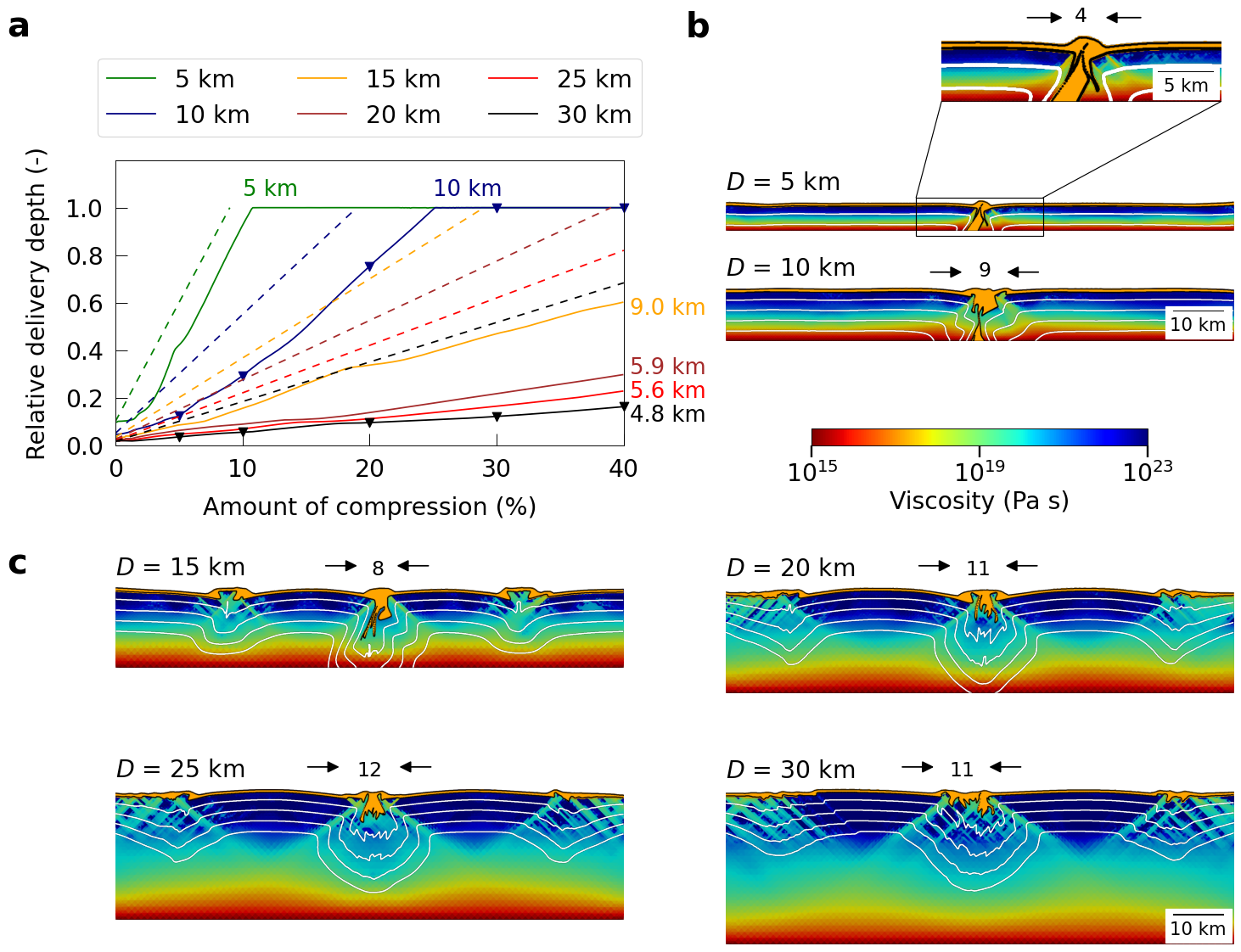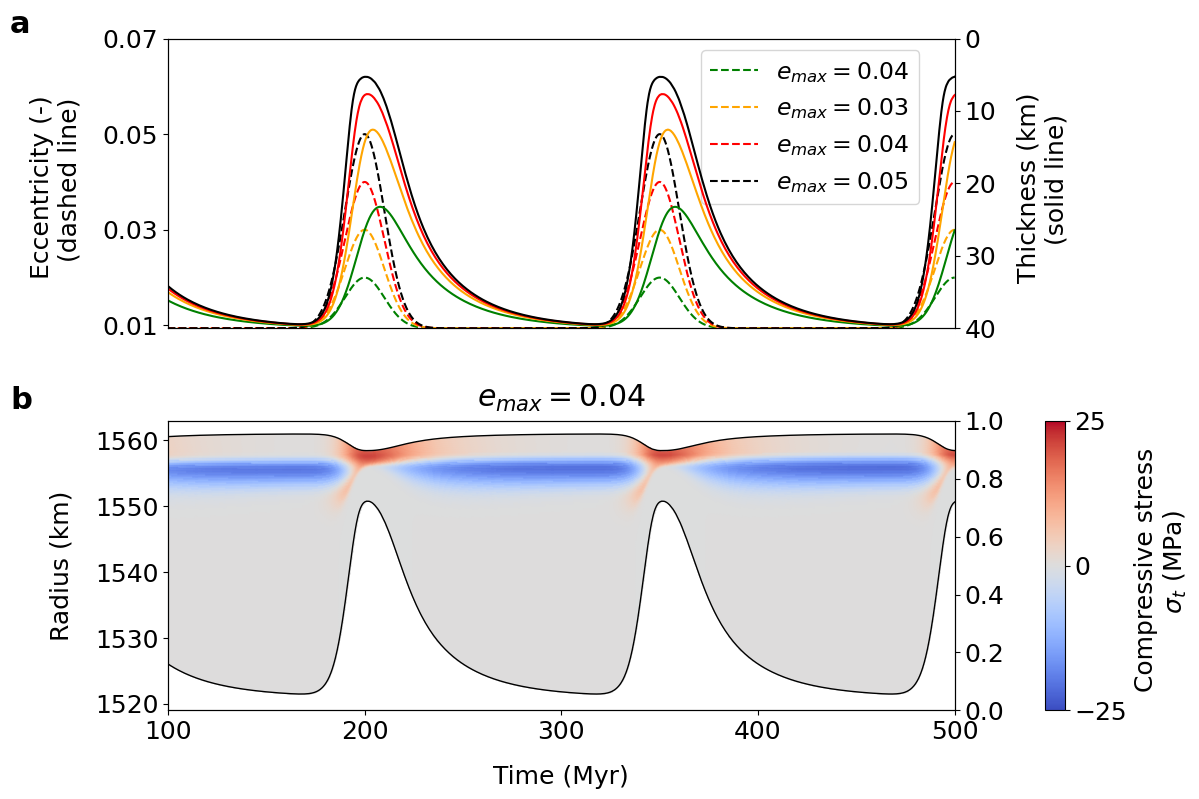Eccentricity variations trigger “subduction” in Europa’s ice shell
- 1Department of Geophysics, Charles University, Faculty of Mathematics and Physics, V Holešovičkách 2, Praha 8, 180 00, Czech Republic (kihoulou@karel.troja.mff.cuni.cz)
- 2Nantes Université, Univ Angers, Le Mans Université, CNRS, Laboratoire de Planétologie et Géosciences, LPG UMR 6112, 44000 Nantes, France
Introduction
Icy moon Europa possesses one of the youngest surfaces in the Solar System. Overall smooth, yet rich in unique tectonic features, it records mostly extensional processes. Nonetheless, reconstructions of tectonic motions at Europa’s surface identified ca 20,000 km2 that have disappeared over the visible tectonic history (1, 2). As an analogy to Earth, subduction has been proposed as a process accommodating the convergent tectonic motions (1). Later models, however, demonstrated that the limited density contrast in the ice shell prevents spontaneous sinking, implying that subduction has to be driven by external forces (3, 4). Here we model i) lateral compression of an ice shell, investigating the transport of near-surface ice and ii) stresses in a spherical ice shell thinning due to enhanced tidal heat production as a possible mechanism for triggering global compression. Finally, we evaluate the amount of material that could be recycled during such an event.
Method
In order to model tectonic deformation of ice, we developed a 2D Cartesian model with visco-elasto-plastic rheology, capturing both ductile flow and brittle failure of the material (5, 6). Fixed temperature is prescribed on the surface and ice-water interface (90 and 270 K, respectively), while the vertical boundaries are adiabatic. The top and bottom boundaries can evolve freely, however, we assume that the topography at the ice-ocean interface is immediately erased by melting and freezing (7). Tectonic deformation is triggered by prescribing convergent velocity 10 mm/yr on the vertical boundaries. To evaluate the efficiency of subduction, we monitor the position of the near-surface ice, taken as the topmost 500 m of the shell at the beginning of the simulation. For evaluation of global stresses, we modified the approach of ref. (8) by accounting for tidal and radiogenic heating from Europa’s silicate mantle (9). Starting from a 40-km-thick shell, we impose eccentricity variations of various magnitudes and evaluate the radial profile of lateral compressional stress.
Results
First, we performed series of simulations, varying the ice shell thickness D in the range 5 - 30 km. Figure 1a shows the evolution of near-surface ice layer position. Within the simulation, the near-surface ice reaches the subsurface ocean only for thin shells (D = 5 and 10 km, see Fig. 1b). In these cases, only one pair of faults develops, focusing the tectonic deformation into a single narrow site. Downward transport then proceeds with the velocity equal to the compression velocity (compare the slope of the corresponding solid and dashed lines). However, for thicker shells, a cluster of several pairs of faults emerges, yielding wider convergence sites, resulting in slower downward transport of near- surface ice. Moreover, the shell fractures at multiple locations, further decreasing the efficiency of the transport (see Fig. 1c).

Figure 1. Compression of ice shell after 2 Myr. a) Solid lines show evolution of relative delivery depth of near-surface ice (orange layer in panels b) and c)). Dashed lines represent sinking with the same speed as the compression, color numbers denote final depth of the near-surface ice. b) Thickness 5 and 10 km (delivery to the subsurface ocean) c) Thickness 15 – 30 km (no delivery).
Figure 2 shows evolution of a conductive ice shell in reaction to eccentricity variations. When the eccentricity starts to increase from its current value e = 0.0094, the ice shell immediately thins and accumulates compressional stress. Figure 2a shows that already at four times higher eccentricity, the ice shell melts down to 10 km. Figure 2b then shows the stress profile for such a case. The maximum of compressional stress is reached in the top rigid part of the shell at the moment of its minimum thickness. As the eccentricity starts to decrease, compressional stress gradually transforms into extensional. Difference in the ice shell radii shown in Fig. 2b yields surface area contraction of 90,000 km2, which, based on the surface radiolytic production estimated by ref. (10), might deliver up to 2.6 × 109 mol O2 yr −1 into the subsurface ocean.

Figure 2. Ice shell’s response to eccentricity variations. a) Eccentricity variations (dashed line, left axis) and resulting shell thickness variations (solid line, right axis). b) Radial profile of compressive lateral stress for maximum eccentricity of emax = 0.04.
Conclusions
Lateral compression of an ice shell can result in subduction-like process if the ice shell is ≲ 10 km thin, delivering the near-surface ice into the subsurface ocean. For thicker shells, the downward transport proceeds more slowly. Moreover, we show that variations in orbital eccentricity provide a way to simultaneously reduce the ice shell thickness and evoke global compressional stress, conditions plausible for the subduction-like process. Carrying radiolytic oxidants during the period of strong hydrothermal activity, subduction-like process might facilitate ignition of complex chemical reaction in the subsurface ocean.
Acknowledgments
This research is supported by Agence Nationale de la Recherche ANR-2020-CE49-0010, Czech Science Foundation project 22-20388S, Charles University project SVV 260709 and Charles University project GA UK 26624.
References
1. Kattenhorn and Prockter (2014), Nat. Geosci. 7, 762–767.
2. Collins et al. (2022), J. Geophys. Res. Planets 127, e2022JE007492
3. Johnson et al. (2017), J. Geophys. Res. Planets 122, 2765–2778.
4. Howell and Pappalardo (2019), Icarus 322, 69–79.
5. Goldsby and Kohlstedt (2001), J. Geophys. Res.: Sol. Ea. 106, 11017–11030.
6. Buck et al. (1998), Faulting and Magmatism at Mid-Ocean Ridges, AGU, pp. 305–323.
7. Kvorka and Čadek (2024), Icarus 412, 115985.
8. Rudolph et al. (2022), Geophys. Res. Lett. 49, e2021GL094421.
9. Běhounková et al. (2021), Geophys. Res. Lett. 48, e2020GL090077.
10. Szalay et al. (2024), Nat. Astron.
How to cite: Kihoulou, M., Choblet, G., Tobie, G., Kalousová, K., and Čadek, O.: Eccentricity variations trigger “subduction” in Europa’s ice shell, Europlanet Science Congress 2024, Berlin, Germany, 8–13 Sep 2024, EPSC2024-311, https://doi.org/10.5194/epsc2024-311, 2024.